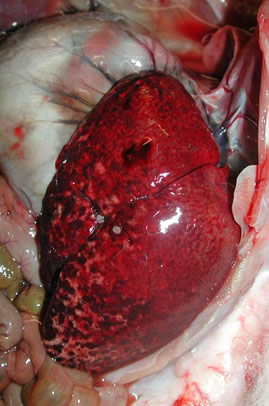Etiology: RHDV is a calicivirus, a nonenveloped RNA virus.
Incidence: The incidence of RHDV is rare.
Transmission: The agent is primarily transmitted by direct contact, although fomites may facilitate the spread of the virus. Rabbits which recover from the disease may continue to shed virus for up to a month. The rabbit is the only host for this disease.
Clinical Signs: The virus occurs in rabbits greater than 2 months of age. In epidemics, the clinicl course of the disease lasts about 2 weeks. The peracute disease is manifested by death without clinical signs. In acute disease, acute onset of anorexia, lethargy, fever, and depression occur and may be followed by labored respiration, tachycardia, abdominal distension, constipation, or diarrhea. Hypothermia, epistaxis and convulsions occur in the terminal stages. Death may occur within 2 to 3 hours after the onset of clinical signs. In disease outbreaks, morbidity may reach 80% with 100% mortality. In endemic infections, mortality may be low.
Pathology: Lesions are associated with consumptive coagulopathy. Tracheal hemorrhages, petechia on the myocardium, kidney, and spleen, pulmonary edema and congestion, and widespread hepatic necrosis are frequently observed at necropsy.

Diagnosis: The disease is tentatively diagnosed based on the rapidly fatal infection and gross necropsy findings. Serology can be used. PCR on liver tissue is used to confirm the postmortem diagnosis.
Public Health Significance: The disease should be reported to the state veterinarian and the USDA.